oil LAND ROVER DEFENDER 1996 Workshop Manual
[x] Cancel search | Manufacturer: LAND ROVER, Model Year: 1996, Model line: DEFENDER, Model: LAND ROVER DEFENDER 1996Pages: 455, PDF Size: 6.44 MB
Page 8 of 455

INTRODUCTION
3
INFORMATION SYNTHETIC RUBBER
Many 'O' ring seals, flexible pipes and other similar
items which appear to be natural rubber are made of
synthetic materials called Fluoroelastomers. Under
normal operating conditions this material is safe, and
does not present a health hazard. However, if the
material is damaged by fire or excessive heat, it can
break down and produce highly corrosive Hydrofluoric
acid which can cause serious burns on contact with
skin. Should the material be in a burnt or overheated
condition handle only with seamless industrial gloves.
Decontaminate and dispose of the gloves immediately
after use.
If skin contact does occur, remove any contaminated
clothing immediately and obtain medical assistance
without delay. In the meantime, wash the affected
area with copious amounts of cold water or limewater
for fifteen to sixty minutes.
RECOMMENDED SEALANTS
A number of branded products are recommended in
this manual for use during maintenance and repair
work.
These items include:
HYLOMAR GASKET AND JOINTING COMPOUND
and
HYLOSIL RTV SILICONE COMPOUND.
They should be available locally from garage
equipment suppliers. If there is any problem obtaining
supplies, contact the following company for advice
and the address of the nearest supplier.
MARSTON LUBRICANTS LTD.
Hylo House,
Cale Lane,
New Springs,
Wigan WN2 1JR
Tel 01942 824242USED ENGINE OIL
WARNING: Prolonged and repeated
contact with engine or motor oil will result
in the removal of natural fats from the
skin, leading to dryness, irritation and dermatitis.
Used engine oil contains potentially harmful
contaminants which may cause skin cancer.
Adequate means of skin protection and washing
facilities should be provided.
Handling precautions
1.Avoid prolonged and repeated contact with oils,
particularly used engine oils.
2.Wear protective clothing, including impervious
gloves where applicable.
3.Do not put oily rags in pockets.
4.Avoid contaminating clothes, particularly
underwear, with oil.
5.Overalls must be cleaned regularly. Discard
unwashable clothing and oil impregnated
footwear.
6.First aid treatment must be obtained immediately
for open cuts and wounds.
7.Use barrier creams, before each work period, to
help the removal of oil from the skin.
8.Wash with soap and water to ensure all oil is
removed (skin cleansers and nail brushes will
help). Preparations containing lanolin replace the
natural skin oils which have been removed.
9.Do not use gasoline, kerosene, diesel fuel,
petrol, thinners or solvents for washing the skin.
10.If skin disorders develop, obtain medical advice.
11.Where practicable, degrease components prior
to handling.
12.Where there is a risk of eye contact, eye
protection should be worn, for example, goggles
or face shields; in addition an eye wash facility
should be provided.
Disposing of used oils
Environmental protection precaution
It is illegal to pour used oil onto the ground, down
sewers or drains, or into waterways.
Dispose of used oil through authorised waste disposal
contractors. If in doubt contact your Local Authority for
advice on disposal facilities.
Page 13 of 455
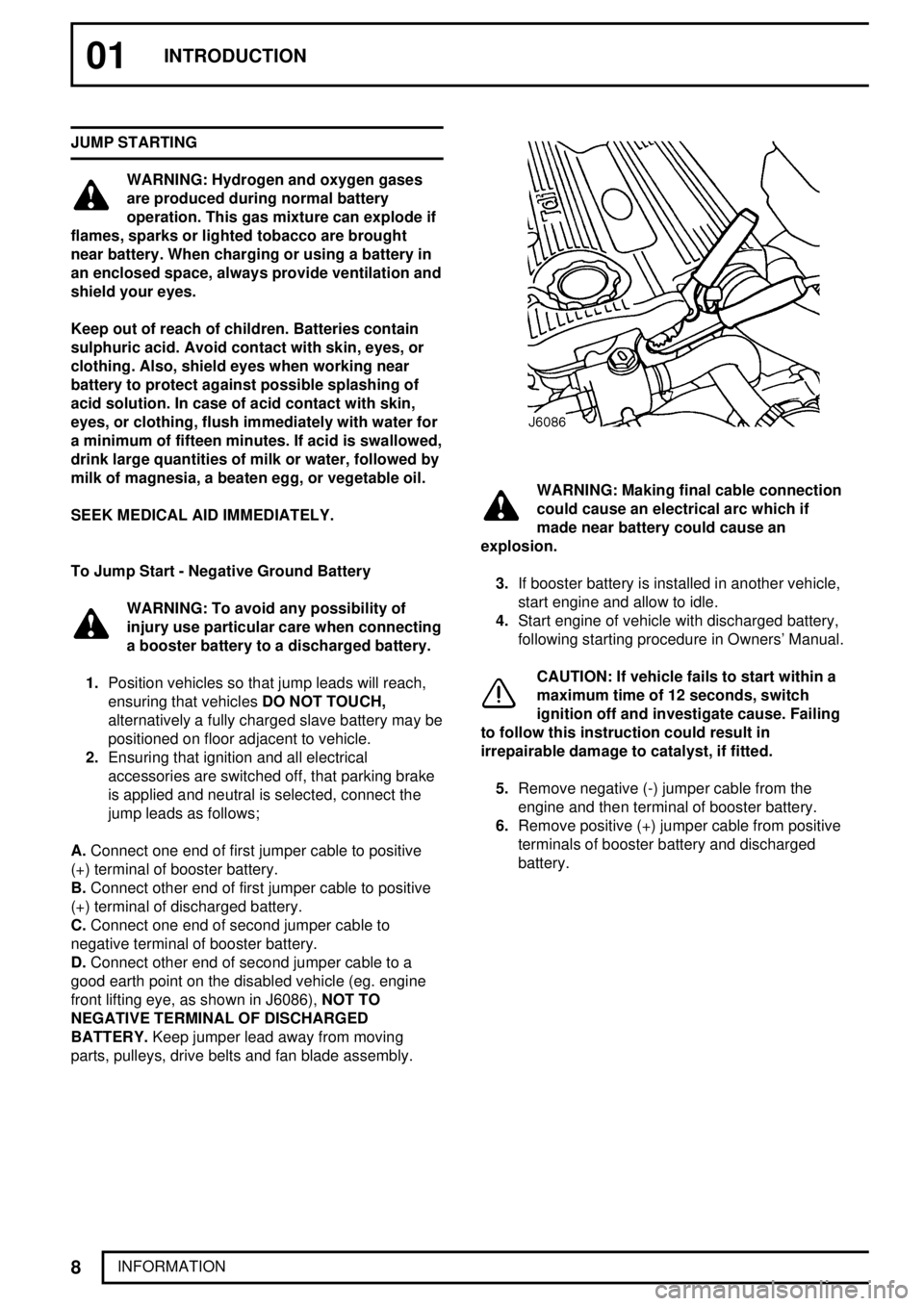
01INTRODUCTION
8
INFORMATION JUMP STARTING
WARNING: Hydrogen and oxygen gases
are produced during normal battery
operation. This gas mixture can explode if
flames, sparks or lighted tobacco are brought
near battery. When charging or using a battery in
an enclosed space, always provide ventilation and
shield your eyes.
Keep out of reach of children. Batteries contain
sulphuric acid. Avoid contact with skin, eyes, or
clothing. Also, shield eyes when working near
battery to protect against possible splashing of
acid solution. In case of acid contact with skin,
eyes, or clothing, flush immediately with water for
a minimum of fifteen minutes. If acid is swallowed,
drink large quantities of milk or water, followed by
milk of magnesia, a beaten egg, or vegetable oil.
SEEK MEDICAL AID IMMEDIATELY.
To Jump Start - Negative Ground Battery
WARNING: To avoid any possibility of
injury use particular care when connecting
a booster battery to a discharged battery.
1.Position vehicles so that jump leads will reach,
ensuring that vehiclesDO NOT TOUCH,
alternatively a fully charged slave battery may be
positioned on floor adjacent to vehicle.
2.Ensuring that ignition and all electrical
accessories are switched off, that parking brake
is applied and neutral is selected, connect the
jump leads as follows;
A.Connect one end of first jumper cable to positive
(+) terminal of booster battery.
B.Connect other end of first jumper cable to positive
(+) terminal of discharged battery.
C.Connect one end of second jumper cable to
negative terminal of booster battery.
D.Connect other end of second jumper cable to a
good earth point on the disabled vehicle (eg. engine
front lifting eye, as shown in J6086),NOT TO
NEGATIVE TERMINAL OF DISCHARGED
BATTERY.Keep jumper lead away from moving
parts, pulleys, drive belts and fan blade assembly.
WARNING: Making final cable connection
could cause an electrical arc which if
made near battery could cause an
explosion.
3.If booster battery is installed in another vehicle,
start engine and allow to idle.
4.Start engine of vehicle with discharged battery,
following starting procedure in Owners' Manual.
CAUTION: If vehicle fails to start within a
maximum time of 12 seconds, switch
ignition off and investigate cause. Failing
to follow this instruction could result in
irrepairable damage to catalyst, if fitted.
5.Remove negative (-) jumper cable from the
engine and then terminal of booster battery.
6.Remove positive (+) jumper cable from positive
terminals of booster battery and discharged
battery.
Page 19 of 455
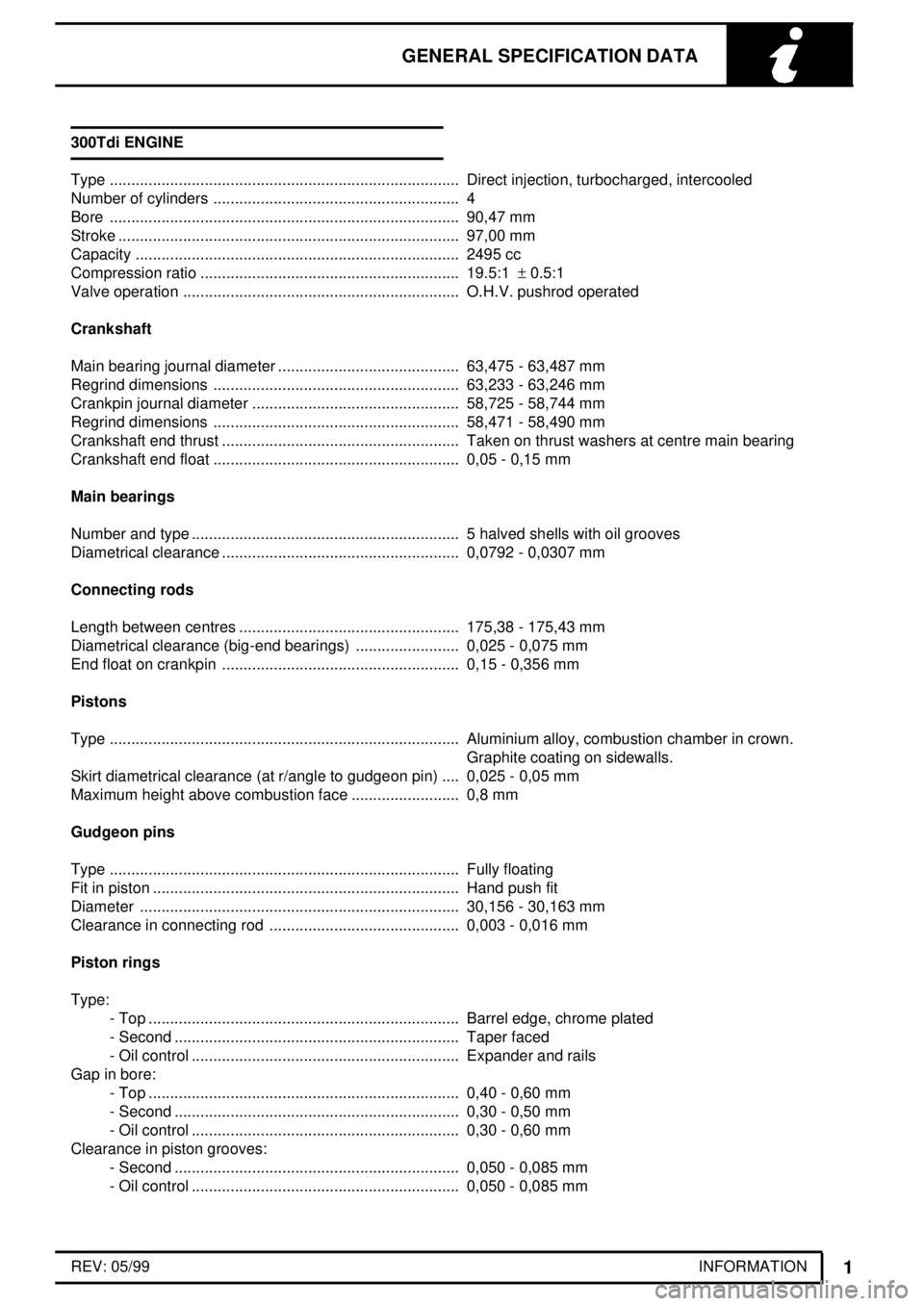
GENERAL SPECIFICATION DATA
1
INFORMATION REV: 05/99 300Tdi ENGINE
Type Direct injection, turbocharged, intercooled.................................................................................
Number of cylinders 4.........................................................
Bore 90,47 mm.................................................................................
Stroke 97,00 mm...............................................................................
Capacity 2495 cc...........................................................................
Compression ratio 19.5:1±0.5:1 ............................................................
Valve operation O.H.V. pushrod operated................................................................
Crankshaft
Main bearing journal diameter 63,475 - 63,487 mm..........................................
Regrind dimensions 63,233 - 63,246 mm.........................................................
Crankpin journal diameter 58,725 - 58,744 mm................................................
Regrind dimensions 58,471 - 58,490 mm.........................................................
Crankshaft end thrust Taken on thrust washers at centre main bearing.......................................................
Crankshaft end float 0,05 - 0,15 mm.........................................................
Main bearings
Number and type 5 halved shells with oil grooves..............................................................
Diametrical clearance 0,0792 - 0,0307 mm.......................................................
Connecting rods
Length between centres 175,38 - 175,43 mm...................................................
Diametrical clearance (big-end bearings) 0,025 - 0,075 mm........................
End float on crankpin 0,15 - 0,356 mm.......................................................
Pistons
Type Aluminium alloy, combustion chamber in crown..................................................................................
Graphite coating on sidewalls.
Skirt diametrical clearance (at r/angle to gudgeon pin) 0,025 - 0,05 mm....
Maximum height above combustion face 0,8 mm.........................
Gudgeon pins
Type Fully floating.................................................................................
Fit in piston Hand push fit.......................................................................
Diameter 30,156 - 30,163 mm..........................................................................
Clearance in connecting rod 0,003 - 0,016 mm............................................
Piston rings
Type:
- Top Barrel edge, chrome plated........................................................................
- Second Taper faced..................................................................
- Oil control Expander and rails..............................................................
Gap in bore:
- Top 0,40 - 0,60 mm........................................................................
- Second 0,30 - 0,50 mm..................................................................
- Oil control 0,30 - 0,60 mm..............................................................
Clearance in piston grooves:
- Second 0,050 - 0,085 mm..................................................................
- Oil control 0,050 - 0,085 mm..............................................................
Page 20 of 455
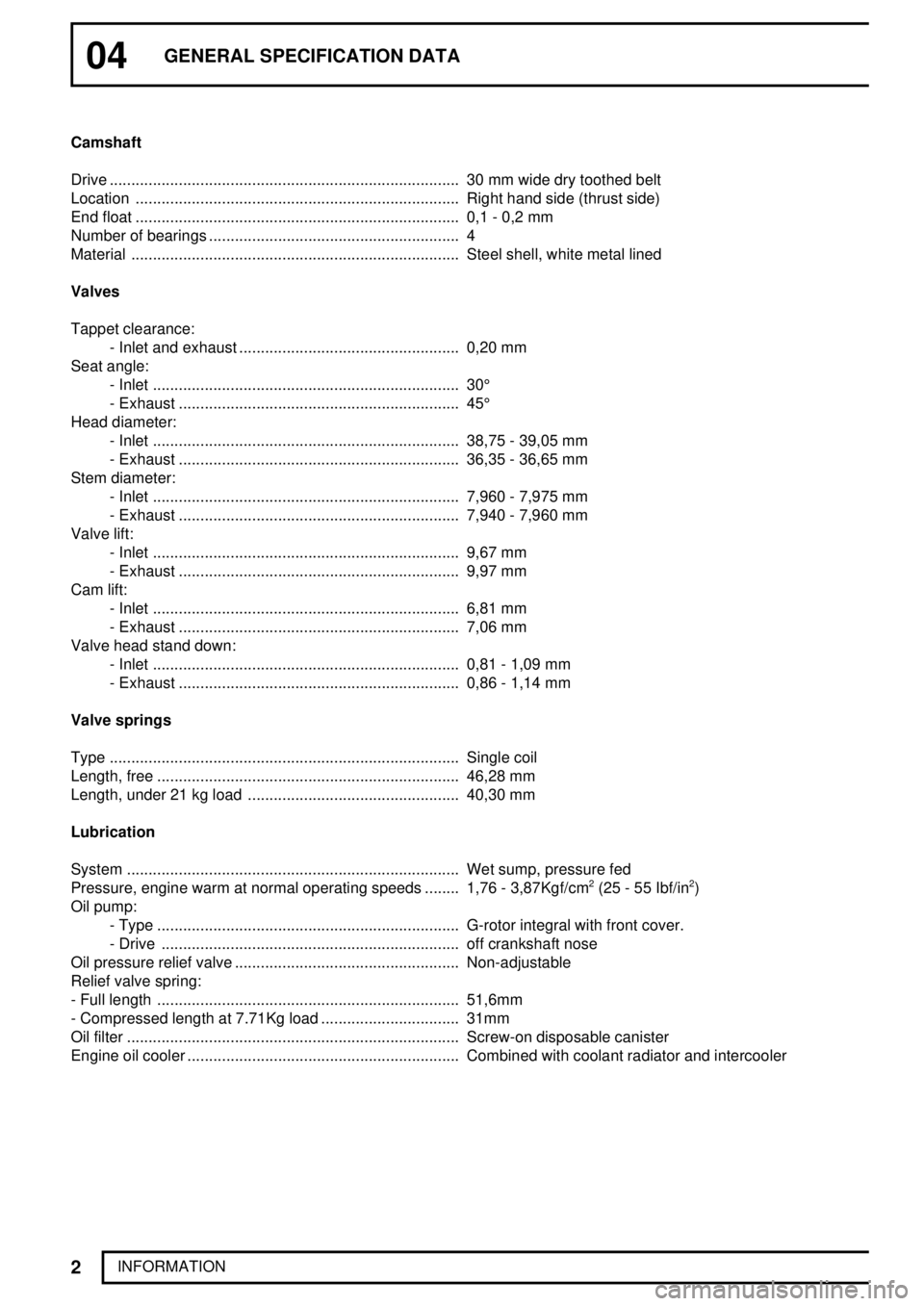
04GENERAL SPECIFICATION DATA
2
INFORMATION Camshaft
Drive 30 mm wide dry toothed belt.................................................................................
Location Right hand side (thrust side)...........................................................................
End float 0,1 - 0,2 mm...........................................................................
Number of bearings 4..........................................................
Material Steel shell, white metal lined............................................................................
Valves
Tappet clearance:
- Inlet and exhaust 0,20 mm...................................................
Seat angle:
- Inlet 30° .......................................................................
- Exhaust 45° .................................................................
Head diameter:
- Inlet 38,75 - 39,05 mm.......................................................................
- Exhaust 36,35 - 36,65 mm.................................................................
Stem diameter:
- Inlet 7,960 - 7,975 mm.......................................................................
- Exhaust 7,940 - 7,960 mm.................................................................
Valve lift:
- Inlet 9,67 mm.......................................................................
- Exhaust 9,97 mm.................................................................
Cam lift:
- Inlet 6,81 mm.......................................................................
- Exhaust 7,06 mm.................................................................
Valve head stand down:
- Inlet 0,81 - 1,09 mm.......................................................................
- Exhaust 0,86 - 1,14 mm.................................................................
Valve springs
Type Single coil.................................................................................
Length, free 46,28 mm......................................................................
Length, under 21 kg load 40,30 mm.................................................
Lubrication
System Wet sump, pressure fed.............................................................................
Pressure, engine warm at normal operating speeds 1,76 - 3,87Kgf/cm
2(25 - 55 Ibf/in2) ........
Oil pump:
- Type G-rotor integral with front cover.......................................................................
- Drive off crankshaft nose.....................................................................
Oil pressure relief valve Non-adjustable....................................................
Relief valve spring:
- Full length 51,6mm......................................................................
- Compressed length at 7.71Kg load 31mm................................
Oil filter Screw-on disposable canister.............................................................................
Engine oil cooler Combined with coolant radiator and intercooler...............................................................
Page 21 of 455

GENERAL SPECIFICATION DATA
3
INFORMATION FUEL SYSTEM
Fuel lift pump type Mechanical with hand primer............................................................
Fuel lift pump pressure 42 - 55 Kgf/cm
2(3 - 4 lbf/in2) at 1800 rpm .....................................................
Fuel filter Paper element in disposable canister..........................................................................
Air cleaner Paper element type........................................................................
COOLING SYSTEM
System type Pressurised, spill return, thermostatically controlled.....................................................................
water and anti freeze mixture. Pump assisted thermo
syphon. Coolant radiator combined with oil cooler and
turbo intercooler.
Cooling fan 11 blade axial flow 433 mm diameter, 1.29:1 drive.......................................................................
ratio, with viscous coupling.
Pump type Centrifugal, impellor, belt driven........................................................................
Thermostat opening 88°C .........................................................
Expansion tank cap pressure 1,06 Kgf/cm
2(15 Ibf/in2) (system pressure) ...........................................
CLUTCH
Type Valeo diaphragm spring.................................................................................
Centre plate diameter 235 mm.......................................................
Facing material Verto F202 grooved.................................................................
Release bearing Ball journal...............................................................
TRANSMISSION
Main gearbox
Type R380 Single helical constant mesh.......................................................................
Speeds 5 forward, 1 reverse, all synchromesh.............................................................................
Transfer box
Type LT230 Two speed reduction on main gearbox output. Front......................................................................
and rear drive permanently engaged via a lockable
differential
Rear axle
Type Spiral bevel, fully floating shafts.................................................................................
Ratio 3.54:1.................................................................................
Page 23 of 455
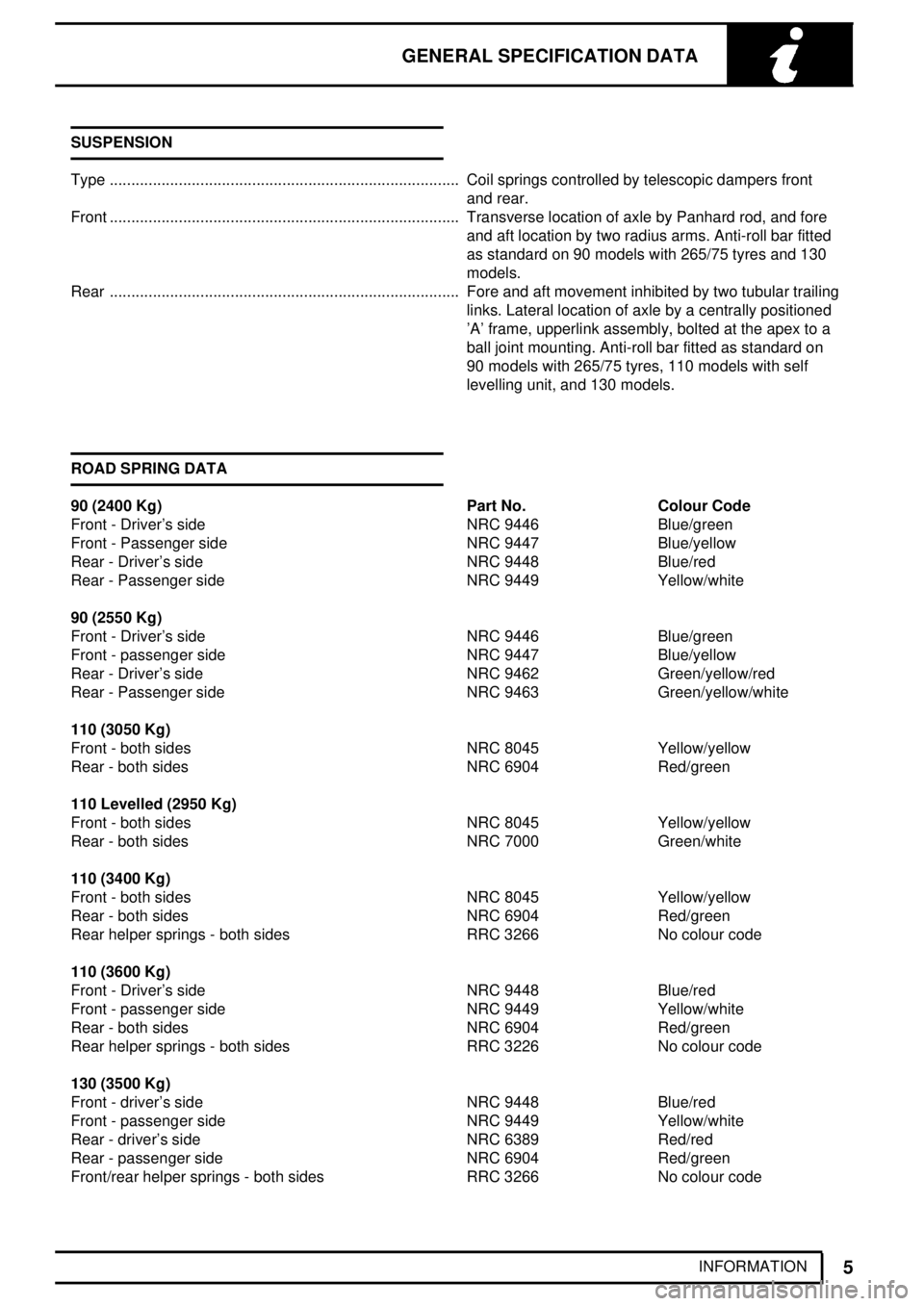
GENERAL SPECIFICATION DATA
5
INFORMATION SUSPENSION
Type Coil springs controlled by telescopic dampers front.................................................................................
and rear.
Front Transverse location of axle by Panhard rod, and fore.................................................................................
and aft location by two radius arms. Anti-roll bar fitted
as standard on 90 models with 265/75 tyres and 130
models.
Rear Fore and aft movement inhibited by two tubular trailing.................................................................................
links. Lateral location of axle by a centrally positioned
'A' frame, upperlink assembly, bolted at the apex to a
ball joint mounting. Anti-roll bar fitted as standard on
90 models with 265/75 tyres, 110 models with self
levelling unit, and 130 models.
ROAD SPRING DATA
90 (2400 Kg) Part No. Colour Code
Front - Driver's side NRC 9446 Blue/green
Front - Passenger side NRC 9447 Blue/yellow
Rear - Driver's side NRC 9448 Blue/red
Rear - Passenger side NRC 9449 Yellow/white
90 (2550 Kg)
Front - Driver's side NRC 9446 Blue/green
Front - passenger side NRC 9447 Blue/yellow
Rear - Driver's side NRC 9462 Green/yellow/red
Rear - Passenger side NRC 9463 Green/yellow/white
110 (3050 Kg)
Front - both sides NRC 8045 Yellow/yellow
Rear - both sides NRC 6904 Red/green
110 Levelled (2950 Kg)
Front - both sides NRC 8045 Yellow/yellow
Rear - both sides NRC 7000 Green/white
110 (3400 Kg)
Front - both sides NRC 8045 Yellow/yellow
Rear - both sides NRC 6904 Red/green
Rear helper springs - both sides RRC 3266 No colour code
110 (3600 Kg)
Front - Driver's side NRC 9448 Blue/red
Front - passenger side NRC 9449 Yellow/white
Rear - both sides NRC 6904 Red/green
Rear helper springs - both sides RRC 3226 No colour code
130 (3500 Kg)
Front - driver's side NRC 9448 Blue/red
Front - passenger side NRC 9449 Yellow/white
Rear - driver's side NRC 6389 Red/red
Rear - passenger side NRC 6904 Red/green
Front/rear helper springs - both sides RRC 3266 No colour code
Page 34 of 455
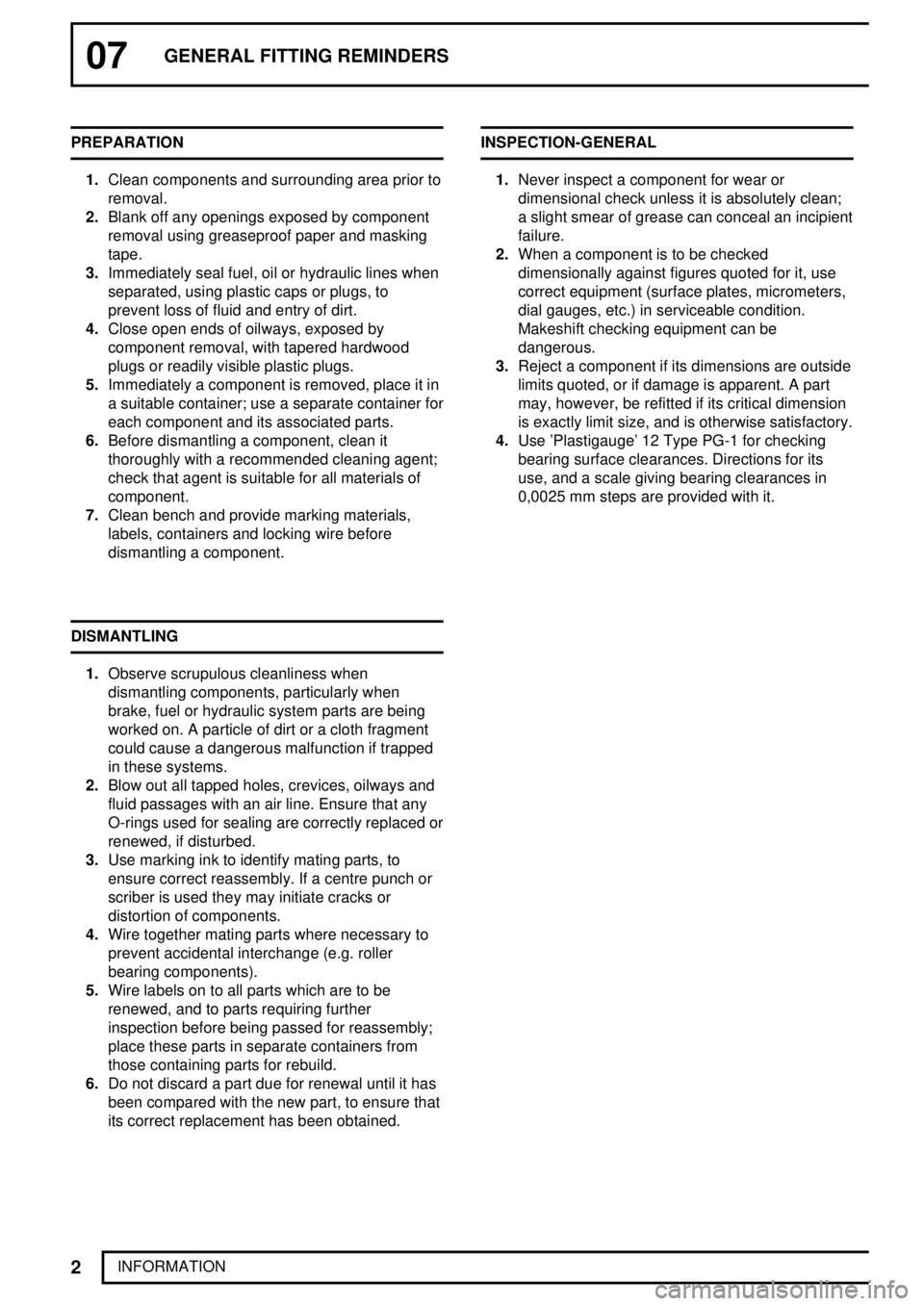
07GENERAL FITTING REMINDERS
2
INFORMATION PREPARATION
1.Clean components and surrounding area prior to
removal.
2.Blank off any openings exposed by component
removal using greaseproof paper and masking
tape.
3.Immediately seal fuel, oil or hydraulic lines when
separated, using plastic caps or plugs, to
prevent loss of fluid and entry of dirt.
4.Close open ends of oilways, exposed by
component removal, with tapered hardwood
plugs or readily visible plastic plugs.
5.Immediately a component is removed, place it in
a suitable container; use a separate container for
each component and its associated parts.
6.Before dismantling a component, clean it
thoroughly with a recommended cleaning agent;
check that agent is suitable for all materials of
component.
7.Clean bench and provide marking materials,
labels, containers and locking wire before
dismantling a component.
DISMANTLING
1.Observe scrupulous cleanliness when
dismantling components, particularly when
brake, fuel or hydraulic system parts are being
worked on. A particle of dirt or a cloth fragment
could cause a dangerous malfunction if trapped
in these systems.
2.Blow out all tapped holes, crevices, oilways and
fluid passages with an air line. Ensure that any
O-rings used for sealing are correctly replaced or
renewed, if disturbed.
3.Use marking ink to identify mating parts, to
ensure correct reassembly. If a centre punch or
scriber is used they may initiate cracks or
distortion of components.
4.Wire together mating parts where necessary to
prevent accidental interchange (e.g. roller
bearing components).
5.Wire labels on to all parts which are to be
renewed, and to parts requiring further
inspection before being passed for reassembly;
place these parts in separate containers from
those containing parts for rebuild.
6.Do not discard a part due for renewal until it has
been compared with the new part, to ensure that
its correct replacement has been obtained.INSPECTION-GENERAL
1.Never inspect a component for wear or
dimensional check unless it is absolutely clean;
a slight smear of grease can conceal an incipient
failure.
2.When a component is to be checked
dimensionally against figures quoted for it, use
correct equipment (surface plates, micrometers,
dial gauges, etc.) in serviceable condition.
Makeshift checking equipment can be
dangerous.
3.Reject a component if its dimensions are outside
limits quoted, or if damage is apparent. A part
may, however, be refitted if its critical dimension
is exactly limit size, and is otherwise satisfactory.
4.Use 'Plastigauge' 12 Type PG-1 for checking
bearing surface clearances. Directions for its
use, and a scale giving bearing clearances in
0,0025 mm steps are provided with it.
Page 36 of 455

07GENERAL FITTING REMINDERS
4
INFORMATION OIL SEALS
NOTE: Ensure that the seal running track
is free from pits, scores, corrosion and
general damage prior to fitting
replacement seal.
1.Always fit new oil seals when rebuilding an
assembly.
2.Carefully examine seal before fitting to ensure
that it is clean and undamaged.
3.Coat the sealing lips with clean grease; pack
dust excluder seals with grease, and heavily
grease duplex seals in cavity between sealing
lips.
4.Ensure that seal spring, if provided, is correctly
fitted.
5.Place lip of seal towards fluid to be sealed and
slide into position on shaft, using fitting sleeve
when possible to protect sealing lip from damage
by sharp corners, threads or splines. If fitting
sleeve is not available, use plastic tube or tape
to prevent damage to sealing lip.
6.Grease outside diameter of seal, place square to
housing recess and press into position, using
great care and if possible a 'bell piece' to ensure
that seal is not tilted. In some cases it may be
preferable to fit seal to housing before fitting to
shaft. Never let weight of unsupported shaft rest
in seal.
7.If correct service tool is not available, use a
suitable drift approximately 0,4 mm (0.015 in)
smaller than outside diameter of seal. Use a
hammerVERY GENTLYon drift if a press is not
suitable.
8.Press or drift seal in to depth of housing if
housing is shouldered, or flush with face of
housing where no shoulder is provided. Ensure
that the seal does not enter the housing in a
tilted position.
NOTE: Most cases of failure or leakage of
oil seals are due to careless fitting, and
resulting damage to both seals and
sealing surfaces. Care in fitting is essential if
good results are to be obtained. NEVER use a seal
which has been improperly stored or handled,
such as hung on a hook or nail.
Page 37 of 455
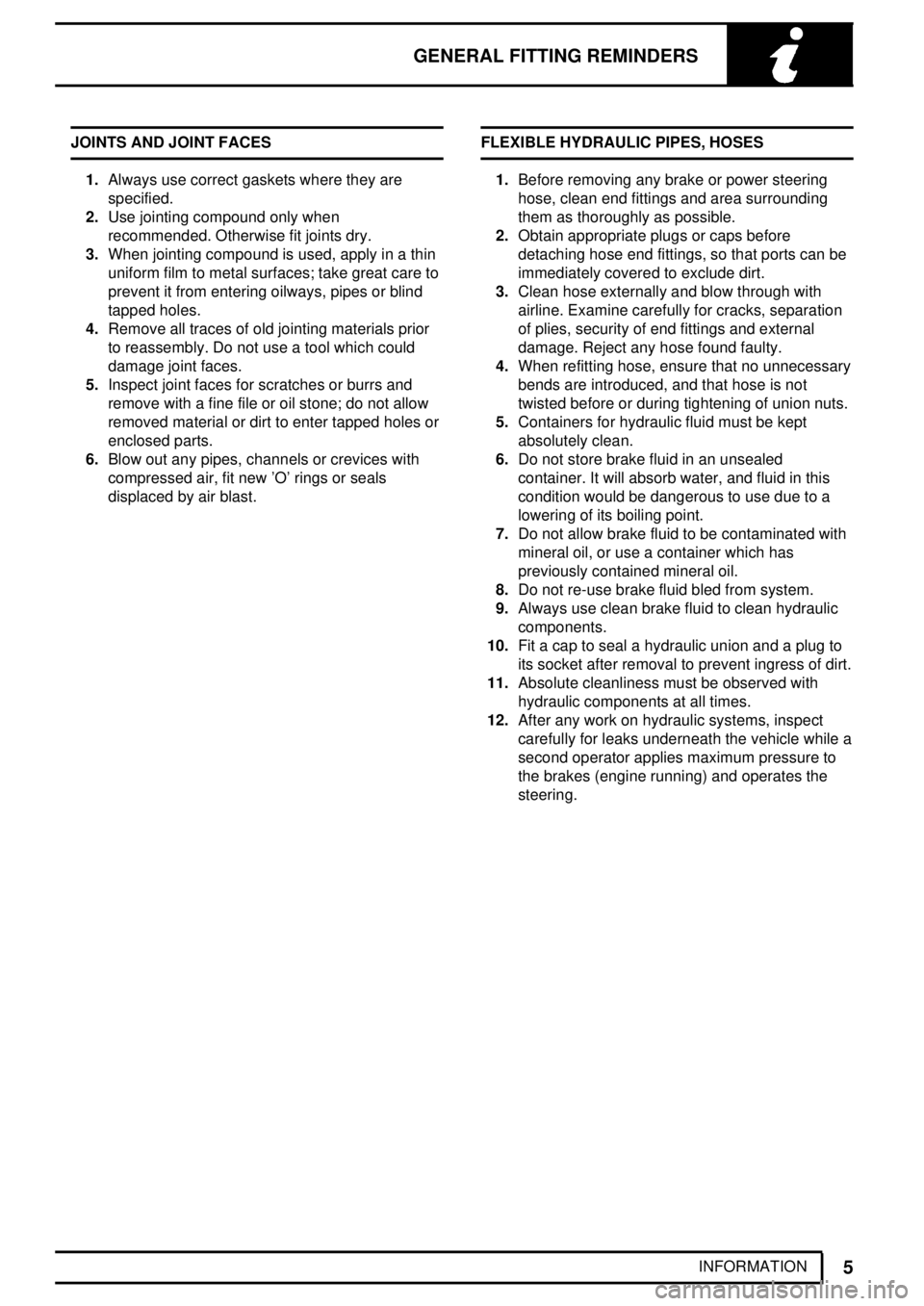
GENERAL FITTING REMINDERS
5
INFORMATION JOINTS AND JOINT FACES
1.Always use correct gaskets where they are
specified.
2.Use jointing compound only when
recommended. Otherwise fit joints dry.
3.When jointing compound is used, apply in a thin
uniform film to metal surfaces; take great care to
prevent it from entering oilways, pipes or blind
tapped holes.
4.Remove all traces of old jointing materials prior
to reassembly. Do not use a tool which could
damage joint faces.
5.Inspect joint faces for scratches or burrs and
remove with a fine file or oil stone; do not allow
removed material or dirt to enter tapped holes or
enclosed parts.
6.Blow out any pipes, channels or crevices with
compressed air, fit new 'O' rings or seals
displaced by air blast.FLEXIBLE HYDRAULIC PIPES, HOSES
1.Before removing any brake or power steering
hose, clean end fittings and area surrounding
them as thoroughly as possible.
2.Obtain appropriate plugs or caps before
detaching hose end fittings, so that ports can be
immediately covered to exclude dirt.
3.Clean hose externally and blow through with
airline. Examine carefully for cracks, separation
of plies, security of end fittings and external
damage. Reject any hose found faulty.
4.When refitting hose, ensure that no unnecessary
bends are introduced, and that hose is not
twisted before or during tightening of union nuts.
5.Containers for hydraulic fluid must be kept
absolutely clean.
6.Do not store brake fluid in an unsealed
container. It will absorb water, and fluid in this
condition would be dangerous to use due to a
lowering of its boiling point.
7.Do not allow brake fluid to be contaminated with
mineral oil, or use a container which has
previously contained mineral oil.
8.Do not re-use brake fluid bled from system.
9.Always use clean brake fluid to clean hydraulic
components.
10.Fit a cap to seal a hydraulic union and a plug to
its socket after removal to prevent ingress of dirt.
11.Absolute cleanliness must be observed with
hydraulic components at all times.
12.After any work on hydraulic systems, inspect
carefully for leaks underneath the vehicle while a
second operator applies maximum pressure to
the brakes (engine running) and operates the
steering.
Page 39 of 455

GENERAL FITTING REMINDERS
7
INFORMATION COTTER PINS
1.Fit new cotter pins throughout when replacing
any unit.
2.Always fit cotter pins where cotter pins were
originally used. Do not substitute spring
washers: there is always a good reason for the
use of a cotter pin.
3.All cotter pins should be fitted as shown unless
otherwise stated.
NUTS
1.When tightening a slotted or castellated nut
never loosen it to insert cotter pin or locking wire
except in those recommended cases where this
forms part of an adjustment. If difficulty is
experienced, alternative washers or nuts should
be selected, or washer thickness reduced.
2.Where self-locking nuts have been removed it is
advisable to replace them with new ones of the
same type.
NOTE: Where bearing pre-load is involved
nuts should be tightened in accordance
with special instructions.
LOCKING WIRE
1.Fit new locking wire of the correct type for all
assemblies incorporating it.
2.Arrange wire so that its tension tends to tighten
the bolt heads, or nuts, to which it is fitted.SCREW THREADS
1.Both UNF and Metric threads to ISO standards
are used. See below for thread identification.
2.Damaged threads must always be discarded.
Cleaning up threads with a die or tap impairs the
strength and closeness of fit of the threads and
is not recommended.
3.Always ensure that replacement bolts are at
least equal in strength to those replaced.
4.Do not allow oil, grease or jointing compound to
enter blind threaded holes. The hydraulic action
on screwing in the bolt or stud could split the
housing.
5.Always tighten a nut or bolt to the recommended
torque value. Damaged or corroded threads can
affect the torque reading.
6.To check or re-tighten a bolt or screw to a
specified torque value first loosen a quarter of a
turn, then re-tighten to the correct value.
7.Oil thread lightly before tightening to ensure a
free running thread, except in the case of
threads treated with sealant/lubricant, and
self-locking nuts.
UNIFIED THREAD IDENTIFICATION
1. Bolts
A circular recess is stamped in the upper surface
of the bolt head.
2. Nuts
A continuous line of circles is indented on one of
the flats of the hexagon, parallel to the axis of
the nut.
3. Studs, Brake Rods, etc.
The component is reduced to the core diameter
for a short length at its extremity.